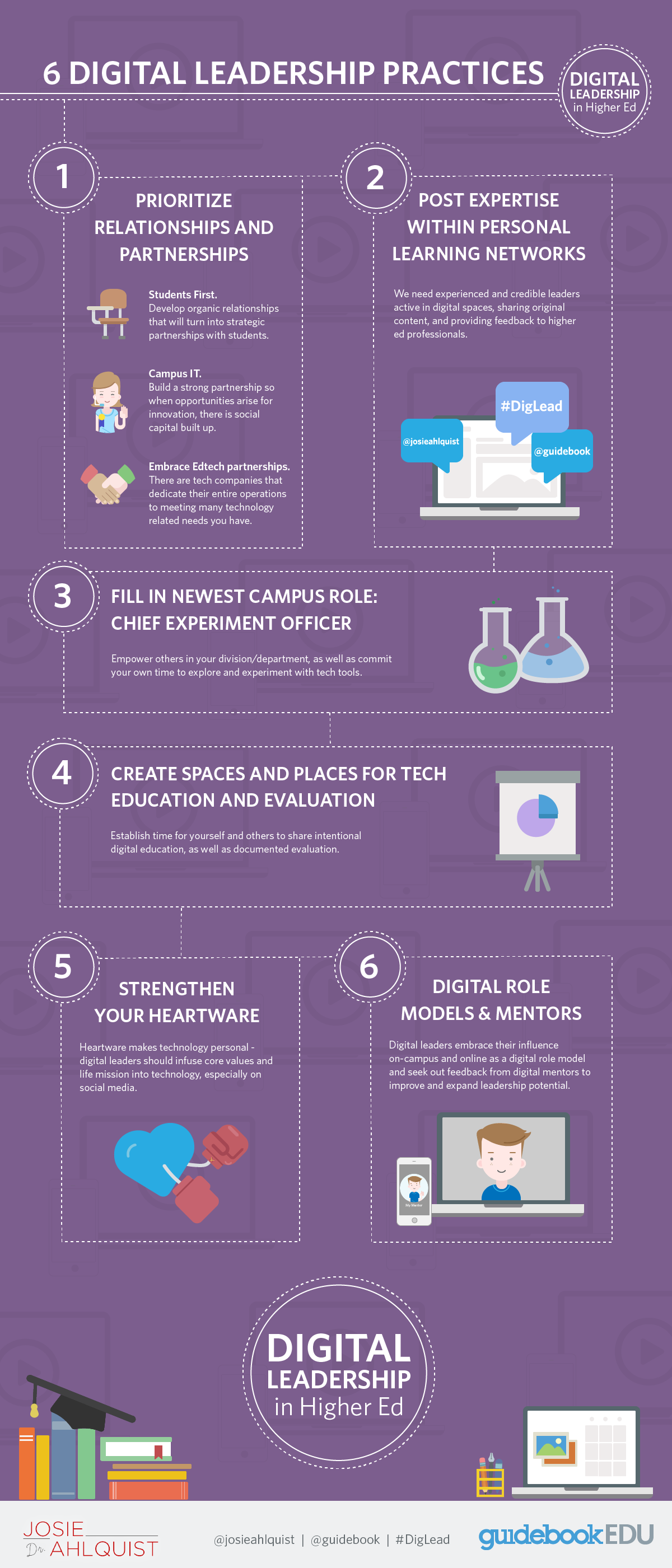6 Digital Leadership Practices in Higher Ed
The following post is part of a series on Digital Leadership in Higher Ed with GuidebookEDU’s Digital Leadership Partner, Josie Ahlquist. You can find her on Twitter, LinkedIn, Facebook & WordPress.
Higher Education leaders no longer have a choice about excelling in virtual, as well as physical, spaces. Not only are high school and college-aged students the highest users of social media, but this fall the ACPA/NASPA Joint Task Force on Student Affairs Professional Competencies approved the addition of a Technology competency. These competencies call upon student affairs educators to expand their vocabulary around, exploration of, and acceleration with technology.
This new competency solidifies technology as an essential part of our work, not just a fad that can be embraced by some and not others.
The Technology (Tech) competency is described as the following:
Focuses on the use of digital tools, resources, and technologies for the advancement of student learning, development, and success as well as the improved performance of student affairs professionals.
In the professional competencies, growth is documented through foundational, intermediate and advanced levels. I have previously blogged in greater detail about the tech competency, as well as tools for foundational level professionals. This post will focus on the advanced level of the Tech competency and tap into a bigger call for Digital Leadership in Higher Education.
With 14 outcomes, becoming a higher education administrator displaying advanced levels of the Tech competencies is no easy task. No matter the specific tech-related outcome, the core of advanced skills in tech is leadership. This goes beyond just being a user, adopter or educator on tools. It is about building relationships, partnerships and spreading empowerment grounded in technology.
This is Digital Leadership.
I recently released my definition of higher education digital leadership on my blog that is based in personalizing technology through human operations and relationships.
A leader can be aware of and implement technology tools, but a digital leader needs to tap into a new tool and skill beyond software and hardware. This tool I call heartware.
“Heartware is your internal operating system as a whole person in the digital age – with core values, life mission, and passion.”
We need conversations about technology in higher education to be based around building stronger communities and connecting people (not users) in all places and spaces.
To this aim, digital leaders must bring the super fans and the Luddites of tech to the table and the ‘tablet’ to find a common purpose. This means digital leaders must be steadfast role models in their own tech use. My research is especially drawn to this type of leadership.
To operationalize specific methods to tap into Digital Leadership, I offer six digital leadership practices, backed up with some outcomes of the advanced level tech competency.
1) Prioritize Relationships and Partnerships.
Students First. Develop organic relationships that will turn into strategic partnerships with students. From interacting with them on Twitter and Instagram to hosting organized focus groups to seek out feedback – students should be your number one priority not only in producing campus services, but also including in technology related decisions.
Your new BFF: Campus IT. Get to know your campus IT Department. This office is more than just submitting work orders or calling to say you want an app developed. Review the organizational chart and find out if there is one member assigned specifically to student affairs. Sometime in the next two months, offer to take this person for coffee to learn more about them and their role on campus. Build a strong partnership so when opportunities arise for innovation, there is social capital built up.
Embrace Edtech partnerships. The reality is that a majority of campuses will not have the means, time or talent to keep up with the daily changes of tech or create their own in-house tools. However, there are tech companies that dedicate their entire operations to meeting much technology related needs you have. While spending money on a vendor may not feel like an equal partnership, this series aims to provide you empowering tools for exploring vendors as well as understanding the value add for products that will meet learning outcomes, university mission, and student engagement.
Advanced Outcomes of Tech Competency
- Collaborate with and support faculty by developing holistic educational and co-curricular opportunities for students in online and hybrid programs promoting the relevance and vision of what student affairs practice in new educational delivery formats.
- Provide leadership for the seamless integration of social media and other digital communications with broader educational, customer service, marketing, and community engagement efforts that communicate and develop dialogue and community around shared common institutional values.
2) Post Expertise within Personal Learning Networks (PLNs).
We need experienced and credible leaders active in digital spaces, sharing original content, and providing feedback to younger professionals. These PLNs can be found on just about every online community.
Advanced Outcomes of the Tech Competency
- Contribute to, partner with, and/or provide leadership for local, state/provincial, national, and global digital professional learning communities and personal learning networks in promoting the use of technology for educational purposes.
3) Fill the Newest Campus Role: CEO (Chief Experiment Officer).
Displaying the ability to adapt, but also embrace change, is a skill required in all professions. Where this skill is taken to the next level as a digital leader is to be a trendsetter and trend spotter. This can be accomplished by empowering others in your division/department, as well as committing time to explore and experiment with tools. Can you set up an environment that experiment (and maybe even failing) is supported by technology?
Advanced Outcomes of the Tech Competency
- Anticipate technological change and allocate personal, departmental, and/or institutional resources to foster in others dispositions of adaptability, flexibility, and openness to technological innovation.
- Contribute to the generation of research, trend analyses, and needs assessments related to digital technologies that inform efforts to meet the technological needs of students, colleagues, and educational stakeholders.
4) Create Spaces and Places for Tech Education & Evaluation.
Building from the experimentation with technology, digital leaders need to establish time for themselves and others to share intentional digital education, as well as documented evaluation. Education can be implemented via local campus resources, outside experts, and even free online tools/tutorials from YouTube, bloggers, and association webinars. As in any other campus effort, assessment must be a priority. This data can come from social media analytics, qualitative student engagement data and usage statistics.
Advanced Outcomes of Tech Competency
- Provide training and instruction for the use, adoption, and evaluation of digital strategies for enhancing educational interventions with multimedia, interactive tools, and creativity enhancing technologies by students, colleagues, and other educational stakeholders.
- Provide leadership for the proactive creation, use, and empirical evaluation of technological tools and digital spaces for students including those drawing on social media and other digital communication and collaboration tools.
5) Strengthen your Heartware.
As noted earlier in this post, heartware makes technology personal – digital leaders must infuse core values and even life calling into use of technology, especially social media. This is where having a digital leadership philosophy is key, one including ethical decision making, student engagement and innovation. In my research, heartware was seen in senior vice presidents who were drawn to tools like Twitter to connect with students and found that by being personable these relationships (and accounts) flourished. How can you bring your heartware into your leadership presence online?
Advanced Outcomes of Tech Competency
- Provide leadership that demands digital information and technologies be used in a manner that is ethical and in full compliance with national and state/province laws as well as with institutional policies.
6) Digital Role Models & Mentors.
Digital leaders embrace influence on-campus and online. Being a digital role model includes formal conversations with colleagues, staff and students, but also the knowledge that how that digital leader uses technology is being passively observed – from when they use their iPhone in a meeting, to what they post on Facebook. A digital leader also needs mentors. You can have a number of digital mentors, both formal (those you ask questions) and informal (those whose technology and social media use you simply monitor). This could be a younger professional more tapped into new technologies, or someone at a level you aspire to in learning how they integrate tech into their professional practices.
Advanced Outcomes of Tech Competency
- Provide leadership and ongoing training to colleagues and students for the cultivation of a genuine digital identity, presence, and reputation that models appropriate online behavior and enable open access and engagement with virtual communities as appropriate.
As technology becomes more woven into our lives I believe we need to take ownership of how we approach and even influence edtech. This is what higher education does best – employing a personal yet strategic approach.
Click the infographic to enlarge it! Tweet about it!
Share this infographic on Twitter!
Want to stay updated on Digital Leadership in Higher Education research and practice? Subscribe to my newsletter, follow me on Twitter @josieahlquist and on my blog at www.josieahlquist.com.
Now read the next article in this series: Building Relationships with Students Using Mobile Technology



